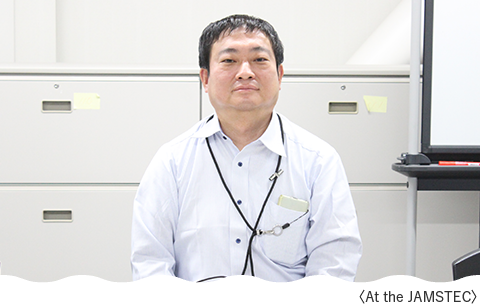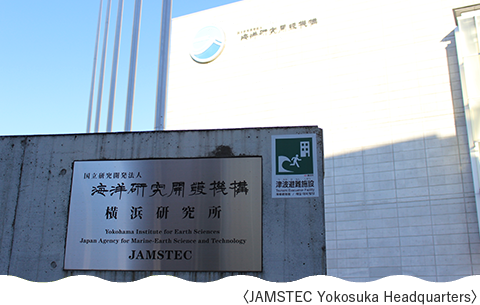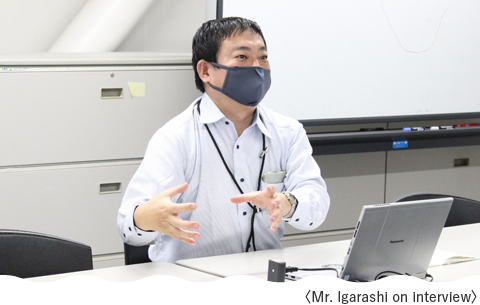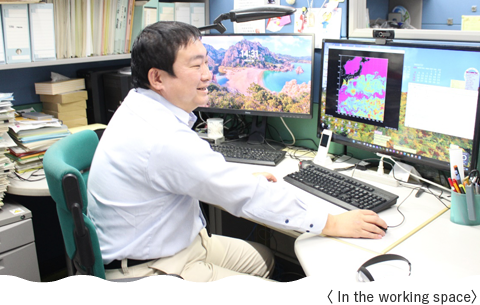
A. I majored in climatology in the Climatology Laboratory of the Department of Geography, Faculty of Science, Tokyo Metropolitan University as an undergraduate student. And then I went on to graduate school at the University of Tsukuba to further my studies in the Laboratory of Climatology and Meteorology, where I earned my master's degree. Before my doctorate, I worked at the National Institute for Environmental Studies in Tsukuba City, the same city as my graduate school, where I spent six months researching yellow dust from China. When I joined JAMSTEC (Japan Agency for Marine-Earth Science and Technology) by chance, I was assigned to work on ocean physics, which was not my specialty at that time, and I started studying ocean research including fisheries science. In 2015, I entered the second semester of the Graduate School of Fisheries Science at Hokkaido University as a working student. I completed the program in 2017, earning a Ph.D. in Fishery Science.
A. My involvement with JAMSTEC began in January 2003 when I was hired by the Frontier Research System for Global Change (FRSGC), jointly funded by NASDA (National Space Development Agency of Japan) and JAMSTEC. Rather than joining JAMSTEC, it may be more accurate to say that I became a member of JAMSTEC when NASDA left the FRSGC. I am still with JAMSTEC's Yokohama Institute for Earth Sciences and will have been there for 20 years in December 2022. Although I initially specialized in meteorology, I joined the FRSGC as a Division of Ocean Physics member. After that, I gradually shifted my research focus to fishery science.
 Q. In a previous interview, Mr. Kawaguchi of the Research Institute for Global Change (RIGC) mentioned that JAMSTEC is an organization that promotes cross-disciplinary and interdisciplinary research. What kind of research is the division to which Mr. Igarashi belongs conducting?
Q. In a previous interview, Mr. Kawaguchi of the Research Institute for Global Change (RIGC) mentioned that JAMSTEC is an organization that promotes cross-disciplinary and interdisciplinary research. What kind of research is the division to which Mr. Igarashi belongs conducting?
A. JAMSTEC covers a wide range of research fields and technologies. Among them, observation research of ocean environments and marine lives using research vessels is one of the core tasks of JAMSTEC, and JAMSTEC plays a vital role in in-situ observation research in the ocean. New marine species have been discovered in a recent survey. So further exploration of still unknown organisms is very important. For this reason, the division of ocean observation study is one of the main parts of JAMSTEC. There is also a division of experiments and analyses of chemistry, biology, and physical properties for developing the theories and verifying various hypotheses. Furthermore, the Research Institute for Value-Added-Information Generation (VAiG) is a division for computing sciences including the estimation of ocean environments in unobserved places and the future prediction based on the completed theory and in-situ observation using numerical models and machine learning technology. The main task of this division is to disseminate the value-added information created in this division to society and make it worthwhile. In our group, Data Synthesis and Fusion Analysis Research Group, the Center for Earth Information Science and Technology, the research focuses on generating new added value by integrating data in different fields. For example, we estimate potential fishing grounds integrating physical ocean environment dataset including ocean temperature, salinity, current velocity etc., and fishery data.

A. One of the main themes of development in VAiG is now "Construction of a Four-Dimensional Virtual Earth" to reproduce and predict the global environment in a virtual space. This theme includes the estimation and prediction of the marine species distribution, and we are creating information useful to society. In the past, I have studied the estimation and prediction of potential fishing grounds for neon flying squid and skipjack tuna in the North Pacific. So, I thought that it was a chance to contribute to the Tokyo Metropolitan Government by creating value-added information of potential fishing grounds of several targets fish species when hearing the Tokyo Metropolitan Government's call for applications. In addition, it was fascinating for me to collaborate with the Tokyo Metropolitan Islands Area Research and Development Center for Agriculture, Forestry and Fisheries, a research institute related to fisheries.
 Q. You plan to conduct research for the next three years. What is your plan for each year?
Q. You plan to conduct research for the next three years. What is your plan for each year?
A. The target species for this research are skipjack tuna and alfonsinos, important fish species for Tokyo. In the first year, we will develop a prototype model for these species as the first product, by integrating collected data of ocean environment and fish catches. Then, based on the first year's results, we will improve the model to increase its accuracy in the second and third years. In addition, we plan to clarify biological characteristics of their habitats and mechanism of fishing ground formations. We consider the model will be improved in the second and third years and we can offer some kinds of products for information delivery to the Tokyo Metropolitan Government. Therefore, we would like to conduct interactive verification with actual users in the third year to improve the model estimation.

A. The first is to create useful information implementing smart fishing for fishermen. Actually, a large amount of fishing cost is occupied by the fuel consumption of fishing vessels. So, the efficient fishing by exploring fishing ground in shorter time based on the accurate estimation and prediction of potential fishing ground will reduce the fuel cost and improve management efficiency. And the improved outlook of the cost and profit will help in well-planned operation of fishing vessels and lead to the improvement of working environment and QOL (quality of life) of fishermen. The second is about the fish catch. As a matter of course, there will be no fish left if we take fish too much as we can. Therefore, fishery resource management based on the scientific knowledge is necessary to avoid such a situation. In this concept, the information of stock level, fishing ground distribution, interannual change of fishing environment etc., will be effective for fisheries management.
Third, this is the most important for management of Okinotorishima and Minamitorishima Islands. It is still significant to manage natural organisms living in remote area where are difficult to observe directly on-site. We expect that numerical model and machine learning approach enables us to create information for managing distant exclusive economic zones without frequent on-site surveys. In fact, not many fishermen in Tokyo go to Okinotorishima and Minamitorishima Islands for operation, and this is why the information of species habitat is important and valuable in terms of managing natural resources in places where fishing does not occur. In other words, the third expected effect is to build a model that will be useful for the conservation and management of the exclusive economic zone.

A. While the accurate 3-dimensional marine environmental dataset is available by applying our technology, we do not have sufficient amount of fishery data. And the difficulty with this research is that the constructed model always includes uncertainty caused by insufficient information on fish distribution, and as the result, our estimation does not always show good performance. In the past research experience, we tried to construct a potential fishing ground estimation model and 10-year hindcast were conducted, but we could not predict perfectly with a single model and one or two years were remained as bad estimation years. Based on this experience, we are developing technology to update a model itself and adapt the current situation with real-time data directly. Furthermore, we feel it is difficult to evaluate the model performance directly. Generally speaking, the model shows better performance in the case that a target fish has high swimming ability and can go everywhere they want. On the other hand, it is necessary to take other factors into account when the amount of target fish cannot be determined by only fishing ground environment. A feedback saying “excellent” from users encourages us because we go make efforts through a lot of trial and error to avoid users disappointment saying “didn’t hit as expected”. We would like to achieve our goals in this project in a way that our prediction model accurately extracts the fishing ground environment near around Okinotorishima and Minamitorishima Islands, and lead to the creation of information that will please the vendors and the people of Tokyo as much as possible.
A. We hope that our research and development will lead to sustainable and smart fishery for fishermen and rich diet with delicious fishes for citizens of Tokyo. To this end, we will continue to develop a system for information creation leading to appropriate fishery management. So, we hope that you will continue to watch over us with encouragement warmly.
